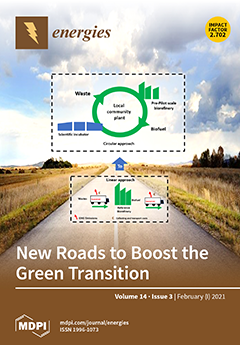Microalgae-derived biomass is currently considered a sustainable feedstock for making biofuels, including biodiesel and direct combustion fuel. The photoautotrophic cultivation of microalgae using flue gas from power plants has been continuously investigated to improve the economic feasibility of microalgae processes. The utilization of
[...] Read more.
Microalgae-derived biomass is currently considered a sustainable feedstock for making biofuels, including biodiesel and direct combustion fuel. The photoautotrophic cultivation of microalgae using flue gas from power plants has been continuously investigated to improve the economic feasibility of microalgae processes. The utilization of waste CO
2 from power plants is advantageous in reducing carbon footprints and the cost of carbon sources. Nonetheless, the sudden interruption of CO
2 supply during microalgal cultivation leads to a severe reduction in biomass productivity. Herein, chemical fertilizers including urea and KH
2PO
4 were added to the culture medium when CO
2 supply was halted. Urea (5 mM) and KH
2PO
4 (5 mM) were present in the culture medium in the form of CO
2/NH
4+ and K
+/H
2PO
4−, respectively, preventing cell growth inhibition. The culture with urea and KH
2PO
4 supplementation exhibited 10.02-fold higher and 7.28-fold higher biomass and lipid productivity, respectively, compared to the culture with ambient CO
2 supply due to the maintenance of a stable pH and dissolved inorganic carbon in the medium. In the mass cultivation of microalgae using flue gas from coal-fired power plants, urea and KH
2PO
4 were supplied while the flue gas supply was shut off. Consequently, the microalgae were grown successfully without cell death.
Full article





